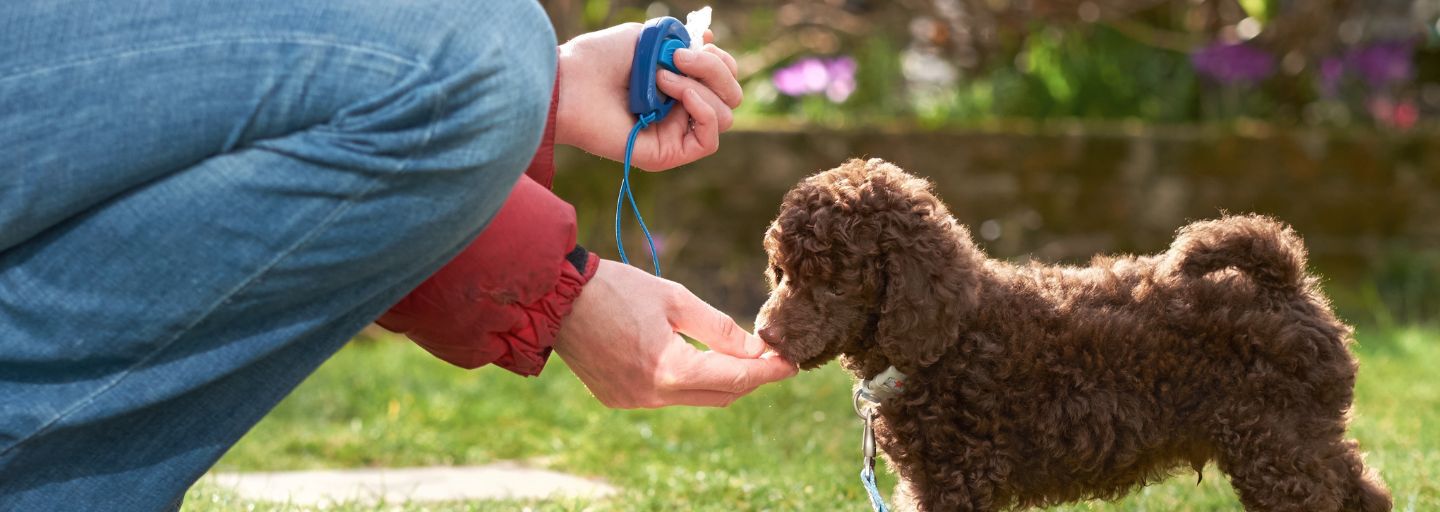Clicker-training is fun and effective, and fast becoming the preferred method of training dogs.
Clickety-clack, don't look back
Clicker training is a simple and effective method of training based on a positive reinforcement reward system. The clicker itself is a simple plastic box with a metal tongue. When compressed, it emits a 'click' sound. The clicker is used to reward a specific behavior and works on your dog’s willingness to want to please you and earn his prize.
The beauty of the clicker is that it is specific to the behavior your dog is exhibiting at the precise time you want to reward it. Praise like, "Who's been a good boy, then!" is not going to be as effective in teaching your dog what will earn him a reward, so it will take him longer to learn the good behavior you’re wanting.
Because the click is sounded while the good behavior is occurring, there can be no doubt in your dog’s mind about what he’s being rewarded for.
Clicker training uses your dog’s own natural desire to learn and obtain a reward without having to use any force or punishment. If your dog does not do what you are trying to teach, he will not get a click reward and so will try harder to do what you want to gain recognition.
Why use a clicker instead of food lure training?
- Using food as a reward is still an essential part of training, at least initially. However, using food rewards alone has some drawbacks:
- Over-treating can lead to obesity.
- Some dogs will grow bored and stop learning if the treats are not used correctly.
- The treat may distract the dog from understanding exactly what he did to earn the reward.
- Treating can lead to the dog refusing to perform a task unless the treat is produced, meaning the dogs will end up only doing as he is asked when the treat is on show.
- Clicker training is consistent among everyone that uses it. Unlike verbal commands, which differ between family members, the click remains the same.
Getting started in clicker training
- As with any training, start in an environment that you and your dog are comfortable and relaxed in.
- Begin to associate the click with a reward by following a click-treat-click-treat-click pattern, holding the clicker out of sight.
- Your dog will eventually begin to associate the clicker with a reward until the click becomes the reward itself.
- In obedience training, you give your dog an idea of what is expected, rewarding him when he does it properly.
For example, 'lure' your dog into the sit position by holding a treat in front of your dog’s nose and move your hand back over his head. As he tries to keep the treat under his nose, his bottom will automatically hit the floor. At this stage, you can click and treat.
As you repeat this, only give treats intermittently and introduce a command. Allow your dog time to work out what you want him to do – and be patient.
Clicker training at any age?
Dog owners often ask when they should start training their puppy. The answer is immediately! Dogs are always learning and may learn unwanted habits, so it's best to teach them early. Start training your pup as soon as you get them, and if you wish to use clicker training, then go for it.
Remember, however, that pups, while they have a lot of energy, also tire easily. Be patient and ensure that you are clear and consistent in the behaviors that you wish them to display.
Just as it’s never too young to start with your puppy, it’s also never too old to begin. Old dogs can learn new tricks. It may, however, take a little longer to learn new habits, and clicker training may not be effective, of course, if your dog is deaf.

